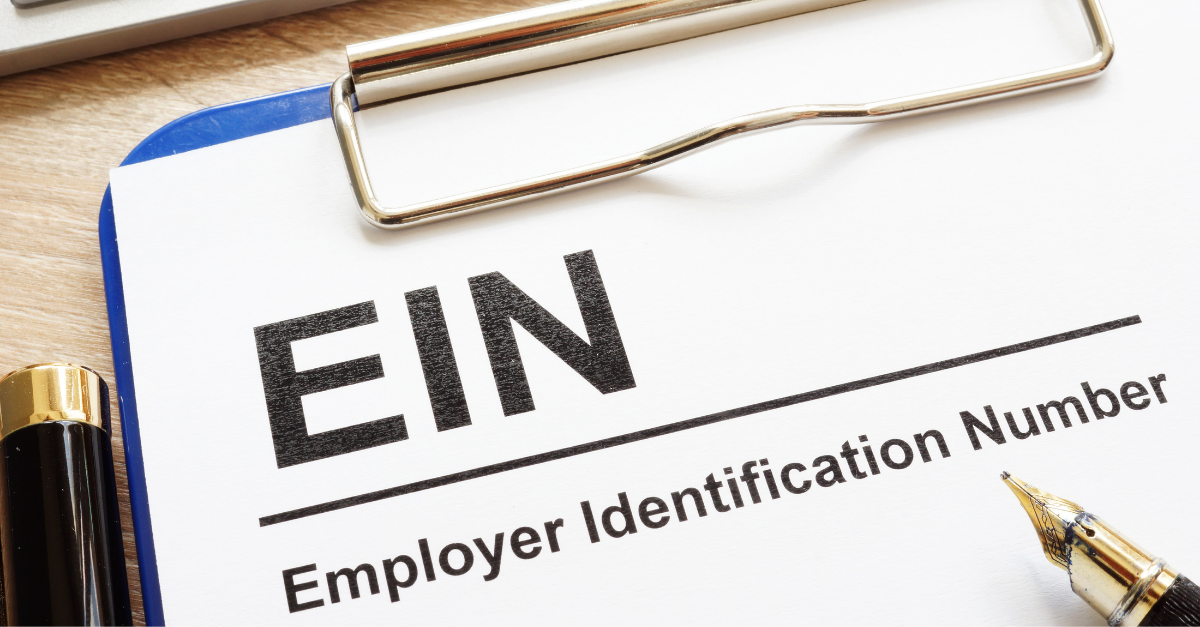As a new business owner, you’ll run into the term "EIN" everywhere, from tax forms to bank applications. But what exactly is an EIN number, and do you need one? And if so, how do you get one? In this comprehensive guide, we will break it all down: the significance of the Employer Identification Numbers (EINs), its purpose, how to fill in an application, and more. If you're an entrepreneur starting a new business or simply seeking information on EINs for future reference, this complete guide is for you. Let’s dive in.
What Is an EIN?
An Employer Identification Number, commonly listed on documents as an EIN, is a unique nine-digit tax identification number issued by the Internal Revenue Service (IRS) to businesses, organizations, and entities operating in the United States. Put simply, think of it as your business's social security number for tax-related/identification purposes. This identifier plays an important role in streamlining systems by, in part, helping you keep a clean record of financial transactions, income, and tax compliance separate from your personal information.
Essentially, as we just briefly touched on, an EIN serves as a distinct designation, separating your business entity from your personal finances. This is important for taxation, hiring employees, opening a business bank account, and a range of other legal and financial activities. Understanding what an EIN is and how to get one is one of the first steps a new business owner should take.
What is an EIN Used for?
We’ve alluded to it, but now let’s get further in-depth: An EIN serves as a multifaceted role within the U.S. tax and regulatory frameworks. Here are some examples below:
1. Federal Tax Filing: At its core, an EIN simplifies and streamlines the process of federal tax filing. It allows businesses to report their income, deductions, and other financial details accurately to the IRS. Whether you're a sole proprietor, a corporation, or a non-profit organization, having an EIN ensures that your tax filings are attributed to your business entity, preventing confusion between personal and business income. This clear account number makes it easier for you, your accountant(s), and the IRS to verify that you have calculated and paid taxes on time, helping you avoid costly errors and stay in compliance with federal tax laws.
2. Facilitating Partnerships and Corporations: When forming a partnership, LLC, or corporation, you will probably need an EIN. It enables such entities to establish their own distinct financial identities, manage income and expenses separately from individual shareholders or partners, and handle complex tax obligations more effectively.
3. Regulatory Compliance: Beyond tax-related use cases, an EIN plays an important role in helping businesses stick to various regulatory requirements imposed by both federal and state authorities. These requirements surround a wide range of areas, from employment to licenses and permits.
An EIN serves as a reference/anchor point for government agencies to help them track and verify a business's compliance with regulations. Without it, businesses may find themselves at risk of penalties, audits, and legal challenges.
Do You Need an EIN?
As we described above, an EIN is essential for most businesses. A business needs an EIN to help manage taxes, follow regulatory requirements, and separate business finances from personal ones. However, not all businesses need one. If you’re running an LLC or sole proprietorship, for example, you can use your social security number in place of an EIN on all business forms. Other types of businesses, however, generally need one.
Benefits of an Employer Identification Number
An EIN offers the following key benefits for businesses:
- Tax Reporting: It simplifies business tax filing, ensuring accurate and organized records separate from personal taxes.
- Separation: It separates business and personal finances, reducing confusion.
- Legal Compliance: It helps prove that you meet regulatory requirements, preventing penalties.
What Are the Differences Between an EIN and Other ID Numbers?
Now that you’re familiar with the idea of an EIN number, you may now wonder about the other related acronyms: TIN and FEIN numbers. Below, we will define the differences between EIN, TIN, and FEIN numbers to clear up any confusion.
EIN vs. TIN
An EIN and a TIN (Taxpayer Identification Number) are both identification numbers used for tax purposes, but they serve different types of entities and have distinct purposes. We described an EIN number above, but let's break down TIN numbers next.
Used for Individuals: A TIN is an identification number used to identify taxable people (an EIN, on the other hand, is used to identify taxable entities). The most common type of TIN is a Social Security Number (SSN) for individuals. Other types include the Individual Taxpayer Identification Number (ITIN) and the Adoption Taxpayer Identification Number (ATIN).
Individuals and Special Cases: While SSNs are primarily for individual taxpayers, ITINs are issued to individuals who are not eligible for a social security number but have a U.S. tax filing requirement, such as non-resident aliens or certain dependents. ATINs are temporary identification numbers issued to adopted children during the adoption process.
EIN vs. FEIN
At the federal level, an EIN and an FEIN (Federal Employer Identification Number) are essentially the same thing. Both terms refer to the same nine-digit tax identification number issued by the IRS to businesses and other entities for tax purposes. The term "EIN" is more commonly used, while "FEIN" is simply another way to refer to this same number. So, there is no practical difference between an EIN and an FEIN; they both serve the same purpose of identifying businesses and organizations for tax-related matters.
How to Apply For an EIN Number
Applying for an EIN is relatively straightforward. But there are quite a few steps and quite a few pieces of information you will need to pull together for the application process. Let’s take a look at the whole EIN application process and the information you’ll need to supply.
1. Ensure You Meet the Eligibility Criteria
When applying for an Employer Identification Number (EIN) from the Internal Revenue Service (IRS), it's important to ensure that you meet the eligibility criteria and requirements. Here's how to do that:
Legal Business Entity: EINs are typically issued to businesses, including sole proprietorships, partnerships, corporations, limited liability companies (LLCs), non-profit organizations, estates, trusts, and other entities. You should have a legally recognized business structure (even including being a freelancer operating a sole proprietorship).
Responsible Party: You need to designate a responsible party who will be the main point of contact for the EIN application. This person should have a valid Social Security Number (SSN) or Individual Taxpayer Identification Number (ITIN). The responsible party is often the owner, partner, or principal officer of the business.
Valid Use: To be eligible for an EIN, you must have a valid reason for needing one. This could be something like conducting business in the United States, hiring employees, opening a business bank account, or fulfilling federal tax obligations.
Non-Duplicative: Double-check and make sure that you do not already have an EIN for the same business entity. Each business should have only one EIN.
Complete and Accurate Information: When filling out your Form SS-4, provide complete and accurate information about your business entity, including its legal name, mailing address, and the reason for applying for an EIN.
Compliance with State Requirements: Ensure you have complied with any state-level requirements for your business. State requirements may vary, so check with your state's business registration agency to confirm what's needed.
2. Familiarize Yourself with the Application Steps
Here are the application steps for obtaining an Employer Identification Number (EIN) from the Internal Revenue Service (IRS):
Before you begin the application process, make sure you meet the eligibility criteria for an EIN. As we’ve touched on, EINs are typically issued to businesses and entities operating in the United States for tax and regulatory/legal purposes. Additionally, the IRS offers several methods for applying for an EIN. You may choose to apply by mail, online, fax, or telephone.
3. Decide Who Will Fill Out the Application
Deciding who should fill out the Employer Identification Number (EIN) application depends on the nature of your business or entity and its organizational structure. Here are some guidelines to help you determine who should complete the EIN application:
Sole Proprietorship: If you are a sole proprietor, you, as the owner, should fill out the EIN application. You will be considered the responsible party and must provide your Social Security Number (SSN) or Individual Taxpayer Identification Number (ITIN).
Partnership: In a partnership, one of the partners is typically designated as the responsible party and should complete the EIN application. This person may be the managing partner or a designated individual with authority.
Limited Liability Company (LLC): In an LLC, the owner or a managing member is usually the responsible party.
Corporation: For corporations, the responsible party is often a corporate officer, such as the president, CEO, or another authorized officer.
Non-Profit Organization: In a non-profit organization, the person who is authorized to act on behalf of the organization, typically the executive director or president, should complete the EIN application.
Estate or Trust: In the case of an estate or trust, the executor or trustee should complete the EIN application.
4. Compile Necessary Documentation for Online Submission
When applying for an Employer Identification Number (EIN) online through the IRS website (irs.gov), you typically don't need to submit any physical documents. However, you will be required to provide specific information about your business or entity during the online application process. Here are the key details you should be prepared to provide:
- Legal Name of the Business: You will need to provide the full legal name of your business or entity. Ensure that the name matches the official name on any legal documents associated with your business.
- Trade Name (if applicable): If your business operates under a different name (also known as a "doing business as" or DBA name), you should also provide this trade name.
- Type of Legal Structure: Indicate the legal structure of your business, such as sole proprietorship, partnership, corporation, LLC, non-profit organization, etc.
- Previous EIN (if applicable): If your business previously had an EIN or is a successor to another business entity, you may be asked to provide information about the previous EIN so they can be properly organized.
- Date Business Started: Specify the date when your business started or the date you acquired an existing business.
5. Grant Required Permissions
At the beginning of the application, the IRS website will request your permission to monitor your activities as you fill out the form. You’ll need to grant these permissions to apply.
6. Provide Your Personal Information
Next, you must provide information about the responsible party, including their name, Social Security Number (SSN) or Individual Taxpayer Identification Number (ITIN), and contact information. If you’re unsure who the responsible party is, you can review the list we put together for you in point three. Generally, however, it’s the person who controls or manages the entity's finances and tax matters.
7. Specify the Purpose of the Application
Next, you’ll need to specify the reason for applying for an EIN. Common reasons include starting a new business, hiring employees, banking purposes, or compliance with IRS tax requirements.
8. Finalize the Authentication Process
Next, the website will request that you verify that you are who you say you are. Depending on your browser capabilities and application, you may need to answer questions about yourself and your past and provide biometric data (like a live photograph) to supplement your identification information.
9. Share Relevant Address Details
You may have to disclose two or more addresses for your business: your physical address and your mailing address. You must provide the physical location or address of your business. This should be a street address, not a P.O. box. If your mailing address is different from your physical address, (for example, if you’d like mail to go to a P.O. box), provide the mailing address where you want to receive official IRS correspondence.
10. Input the Remaining Information
You’re almost done! If applying online, follow the instructions on the EIN Assistant tool and provide the required information. If applying by fax or mail, fill out Form SS-4 accurately and legibly.
11. Confirm EIN Details
Once you think you are ready to submit your application you should double-check that all information was uploaded correctly and there are no errors, as this can delay the application process.
Note: Previous EIN (if applicable): If your business previously had an EIN or is a successor to another business entity, you may be asked to provide information about the previous EIN.
12. Finish and Send the Application
The EIN application process is relatively straightforward, and the method you choose should depend on your convenience and immediate needs. For online applications, follow the prompts to submit your application electronically. You will receive your EIN immediately upon successful submission.
For fax or mail applications, on the other hand, send the completed Form SS-4 to the appropriate fax number or mailing address provided in the instructions. Processing times may vary for these methods.
How to Close Your Employee Identification Number
Closing an Employer Identification Number (EIN) is a straightforward process, but it's essential to ensure that all associated tax obligations and requirements have been satisfied before closing the EIN.
Here are the steps to close an EIN:
Cease Business Operations
Before closing your EIN, ensure that your business or entity has ceased all operations, including hiring employees, generating income, or engaging in any business-related activities.
File Final Tax Returns
Next, you’ll need to file all required federal and state tax returns and pay any outstanding taxes owed. This includes income tax returns, payroll tax returns (if you had employees), and any other applicable tax filings.
Cancel Your EIN With the IRS
To formally close your EIN with the Internal Revenue Service (IRS), you can send a written request to the IRS office where you originally applied for the EIN. Include the following information in your request:
- The legal name of the business or entity associated with the EIN.
- The EIN.
- The reason for closing the EIN (for example, business closure).
- Your name and contact information.
- A copy of the EIN confirmation notice or a previous tax return that includes the EIN.
Notify State and Local Authorities
Depending on your location and the nature of your business, you may need to inform state and local tax agencies of the closure so they can update their records. Check with your state's business regulatory agency or Department of Revenue for specific requirements.
Close Business Accounts
Close any business bank accounts and credit lines associated with the EIN. Ensure that all outstanding debts and financial obligations are settled.
Retain Records
Keep copies of all documents related to the closure of your business and EIN, including confirmation of tax filings, dissolution certificates (if applicable), and correspondence with the IRS and other relevant authorities. These records may be needed for future reference or audits (you’ll need to maintain these records for a minimum of 10 years).
Cancel Business Licenses and Permits
If your business needs specific licenses or permits to operate, make sure to cancel them with the respective issuing authorities.
Employer Identification Number (EIN) FAQs
To obtain an Employer Identification Number (EIN), you will need the following information:
- Legal Name of the Business or Entity
- Trade Name (if applicable)
- Type of Legal Structure
- Physical Address
- Mailing Address (if different from physical address)
- Reason for Applying
- Responsible Party Information
- Date Business Started
If you've misplaced your Employer Identification Number (EIN), you can take the following steps to retrieve it:
- Check Previous Documentation: Review any previous documents, records, or tax returns related to your business or entity. Your EIN may be listed on documents such as previous tax returns, bank statements, or business licenses.
- Contact the IRS: You can contact the IRS for assistance retrieving your EIN
- Look for Confirmation Letter: If you applied for your EIN online, you should have received a confirmation letter from the IRS. Check your records for this letter, as it will contain your EIN.
- Check With Your Bank: If you opened a business bank account, the bank may have a record of your EIN. Contact your bank to inquire if they can provide the EIN associated with your account.
- Contact Your Accountant or Tax Professional: If you work with an accountant or tax professional, they may have a record of your EIN in their files.
Yes, in certain situations you can have multiple EINs. Here are some examples of situations when this could happen:
- Multiple Businesses or Entities
- Succession or Merger
- Trusts and Estates
- Subsidiaries
The processing time for obtaining an Employer Identification Number (EIN) can vary depending on the method you choose to apply. Here are the typical processing times for different application methods:
- Online Application: Applying for an EIN online using the IRS's EIN Assistant tool is the fastest method. In most cases, you will receive your EIN immediately upon completing the online application.
- Fax Application: If you choose to apply by fax, the processing time is relatively quick, usually within 4 business days of application approval.
- Mail Application: Applying by mail typically takes the longest processing time. It may take up to 4 weeks to receive your EIN if you submit a paper application via mail.
Obtaining an Employer Identification Number (EIN) is not always necessary for every business or entity, especially if you don't have employees or other specific reasons to require one. However, there can be some advantages to getting an EIN even if it's not strictly required. These advantages are:
- Keeps your SSN off forms
- Can help add credibility to your business
- Helps you file business taxes
- Can help you with starting a business bank account
- Helps to prevent identity theft
- Loan applications: An EIN can help speed this process along
- An EIN can help build business credit






